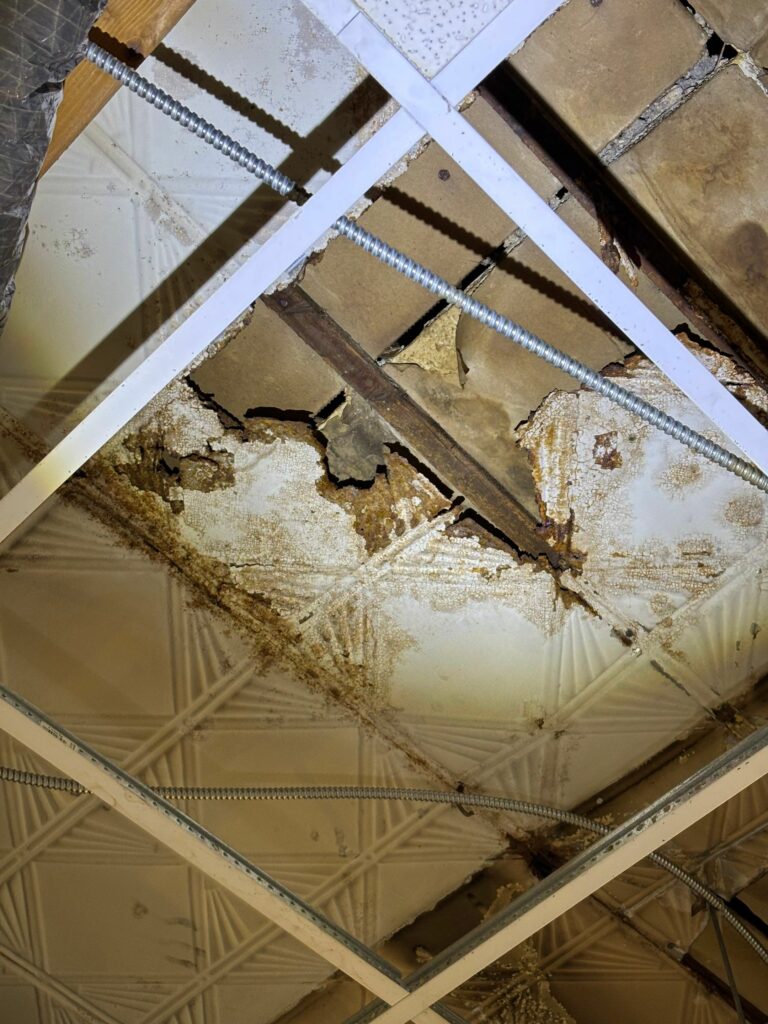Hidden ceiling mold can silently degrade air quality and cause health issues. Discover why early detection & professional mold testing are essential before damage spreads.

What Is Hidden Ceiling Mold?
Hidden ceiling mold refers to fungal growth that occurs above ceiling surfaces—behind drywall, drop ceilings, insulation, or within cavities—but not readily visible from the living spaces below. Because it’s out of sight, many homeowners are unaware of its presence until symptoms appear or damage is visible elsewhere.
Mold spores settle on surfaces, and when moisture is present, they grow and proliferate. In ceilings, moisture sources like roof leaks, condensation in HVAC ducts, plumbing—and even humidity—create ideal conditions for mold development. According to the CDC, mold will grow where moisture is present, including on ceiling tiles, drywall, insulation, and other structural materials. CDC
Why Hidden Ceiling Mold Is a Threat
1. It Destabilizes Indoor Air Quality
Ceiling mold often sits above occupied areas, and its spores can be drawn down through HVAC systems or air circulation, contaminating the rooms below. Over time, this degrades indoor air quality—even if the mold isn’t immediately visible.
2. Health Risks Are Real
Prolonged exposure to mold in damp indoor environments can trigger symptoms such as nasal congestion, wheezing, eye irritation, skin rash, or throat irritation.
In individuals with asthma, allergies, or weakened immune systems, effects can be more severe. CDC
3. Structural Damage Can Occur
Mold not only feeds on moisture, but can degrade ceiling materials, wood framing, and insulation over time. Persistent hidden growth can lead to sagging ceilings, peeling paint, or weakened drywall. The EPA warns that porous ceiling tiles and building materials may need to be discarded if mold has infiltrated them. EPA
How Hidden Ceiling Mold Begins
- Roof leaks & water intrusion: Even minor leaks allow moisture to accumulate above the ceiling.
- HVAC condensation & duct moisture: Poorly sealed or insulated ducts can allow condensation to collect near ceiling cavities.
- Elevated indoor humidity: High humidity (over ~50 %) enables mold spores to germinate.
- Inadequate ventilation: Lack of airflow in attics or crawl spaces traps moisture.
Once moisture persists, mold spores colonize and spread through the underlying substrate, often escaping detection for months or years.
Why Professional Mold Testing Should Be Step One
When facing possible hidden ceiling mold, testing before cleanup ensures you address the root of the problem rather than masking symptoms. Some key advantages:
- Correct identification — Determines mold species and concentration.
- Extent mapping — Reveals how far growth has spread behind ceilings and cavities.
- Remediation planning — Guides safe containment and targeted removal.
- Verification — Post-remediation testing confirms that mold levels are safe again.
The CDC also emphasizes that mold remediation should include not just cleaning but correcting moisture issues. CDC
And while the EPA discourages random air sampling, targeted sampling based on suspicious zones (e.g. above ceilings) can provide useful guidance when interpreted by professionals. CDC
Steps to Address Hidden Ceiling Mold
- Visual & moisture inspection — Use infrared or moisture meters to detect wet zones.
- Air or surface sampling — Under professional guidance.
- Containment & safety — Seal ceiling cavities, use HEPA filtration, wear PPE.
- Removal of contaminated materials — Replace ceiling tiles, drywall, or insulation as needed.
- Drying & dehumidification — Ensure all areas drop below moisture thresholds.
- Post-remediation testing — Confirm that mold counts are back to safe baselines.
The EPA’s Mold Remediation in Schools & Commercial Buildings guide provides remediation standards and containment best practices (useful beyond schools). EPA
Prevention & Maintenance Tips
- Fix roof leaks or plumbing issues quickly.
- Maintain indoor humidity below ~50 % using dehumidifiers.
- Ensure attic and ceiling spaces are ventilated.
- Inspect ceilings regularly for stains, sagging, or musty odors.
- When renovating or opening ceilings, always test first before disturbing materials.
Final Thoughts
Hidden ceiling mold is a silent threat—quietly affecting your air and your health. The only way to expose it is through proper detection and testing. Before repairs or cleanup, invest in professional mold testing to guide a safe, effective remediation strategy.
